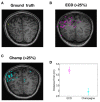Clinical Validation of the Champagne Algorithm for Epilepsy Spike Localization
- PMID: 34093150
- PMCID: PMC8172809
- DOI: 10.3389/fnhum.2021.642819
Clinical Validation of the Champagne Algorithm for Epilepsy Spike Localization
Abstract
Magnetoencephalography (MEG) is increasingly used for presurgical planning in people with medically refractory focal epilepsy. Localization of interictal epileptiform activity, a surrogate for the seizure onset zone whose removal may prevent seizures, is challenging and depends on the use of multiple complementary techniques. Accurate and reliable localization of epileptiform activity from spontaneous MEG data has been an elusive goal. One approach toward this goal is to use a novel Bayesian inference algorithm-the Champagne algorithm with noise learning-which has shown tremendous success in source reconstruction, especially for focal brain sources. In this study, we localized sources of manually identified MEG spikes using the Champagne algorithm in a cohort of 16 patients with medically refractory epilepsy collected in two consecutive series. To evaluate the reliability of this approach, we compared the performance to equivalent current dipole (ECD) modeling, a conventional source localization technique that is commonly used in clinical practice. Results suggest that Champagne may be a robust, automated, alternative to manual parametric dipole fitting methods for localization of interictal MEG spikes, in addition to its previously described clinical and research applications.
Keywords: brain source imaging; brain source localization; epilepsy; magnetoencephalography; source imaging analysis; source localization; spike analysis.
Copyright © 2021 Cai, Chen, Findlay, Mizuiri, Sekihara, Kirsch and Nagarajan.
Conflict of interest statement
KS was employed by company Signal Analysis Inc. The remaining authors declare that the research was conducted in the absence of any commercial or financial relationships that could be construed as a potential conflict of interest.
Figures





References
-
- Bagic A. I., Knowlton R. C., Rose D. F., Ebersole J. S., ACMEGS Clinical Practice Guideline (CPG) Committee (2011). American clinical magnetoencephalography society clinical practice guideline 1: recording and analysis of spontaneous cerebral activity. J. Clin. Neurophysiol. 28, 348–354. 10.1097/WNP.0b013e3182272fed - DOI - PubMed

